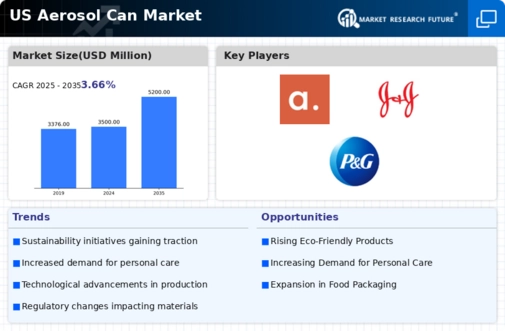Growth in Household Cleaning Products
The aerosol can market is experiencing growth due to the rising demand for household cleaning products. In recent years, the US market for cleaning supplies has expanded, with aerosol-based cleaners gaining popularity for their convenience and effectiveness. Reports indicate that the household cleaning segment is expected to grow at a CAGR of around 4% through 2026. This trend is driven by an increasing focus on hygiene and cleanliness in homes, particularly in urban areas. As consumers seek efficient cleaning solutions, aerosol cans provide a practical option for dispensing various cleaning agents. The growth in this sector not only boosts the aerosol can market but also encourages manufacturers to innovate and diversify their product offerings to meet evolving consumer needs.
Rising Demand for Personal Care Products
The aerosol can market experiences a notable surge in demand driven by the increasing popularity of personal care products. In the US, the personal care segment, which includes items such as deodorants, hair sprays, and skincare products, has shown a growth rate of approximately 5% annually. This trend indicates a shift in consumer behavior towards convenience and ease of use, which aerosol cans provide. The aerosol can market benefits from this demand as manufacturers innovate to create more effective and appealing products. Furthermore, the rise of e-commerce platforms has facilitated access to these products, further propelling market growth. As consumers increasingly prioritize personal grooming and hygiene, the aerosol can market is likely to see sustained growth in this segment, reflecting broader lifestyle changes and preferences.
Expansion of the Food and Beverage Sector
The aerosol can market is significantly impacted by the expansion of the food and beverage sector, particularly in the use of aerosol packaging for food products. The convenience of aerosol cans for dispensing items such as whipped cream, cooking oils, and flavored sprays has led to increased adoption in the culinary space. The US food and beverage market is projected to grow at a rate of approximately 3% annually, with aerosol packaging playing a crucial role in this growth. This trend reflects a broader consumer preference for convenience and portion control in food preparation. As the food industry continues to innovate, the aerosol can market is likely to benefit from new product developments and applications, further solidifying its position within the packaging landscape.
Regulatory Support for Eco-Friendly Packaging
The aerosol can market is positively influenced by regulatory support aimed at promoting eco-friendly packaging solutions. In the US, various state and federal regulations encourage the use of recyclable materials and the reduction of volatile organic compounds (VOCs) in aerosol products. This regulatory landscape not only fosters innovation among manufacturers but also aligns with consumer expectations for sustainable products. As a result, companies are increasingly investing in research and development to create aerosol cans that meet these environmental standards. The market for eco-friendly aerosol cans is projected to grow significantly, with estimates suggesting a potential increase of 10% in market share over the next five years. This regulatory support is crucial for the long-term viability of the aerosol can market, as it drives manufacturers to adopt sustainable practices while meeting consumer demands.
Technological Innovations in Manufacturing Processes
The aerosol can market is witnessing advancements in manufacturing processes that enhance efficiency and product quality. Innovations such as automated production lines and improved filling techniques are streamlining operations, reducing costs, and minimizing waste. These technological improvements are essential for meeting the growing demand for aerosol products across various sectors, including personal care, household cleaning, and food and beverage. As manufacturers adopt these technologies, they can produce aerosol cans more sustainably and at a lower cost, potentially increasing their market share. The ongoing investment in technology is expected to drive growth in the aerosol can market, as companies strive to remain competitive and responsive to consumer preferences.














Leave a Comment